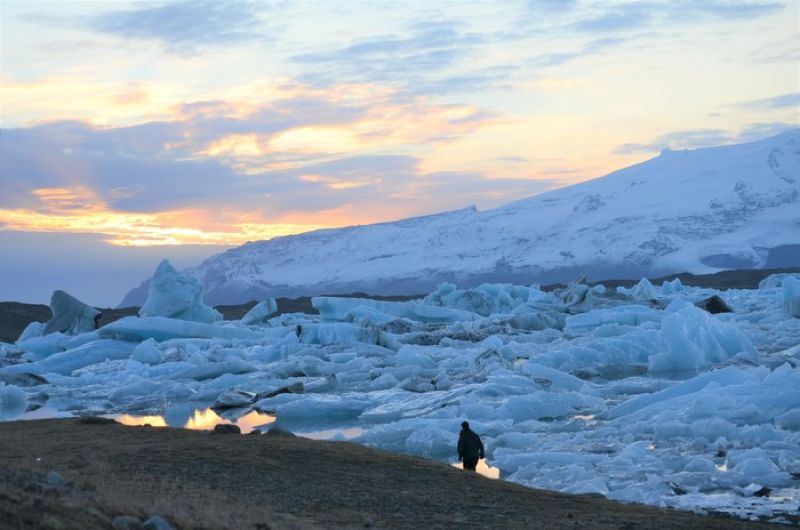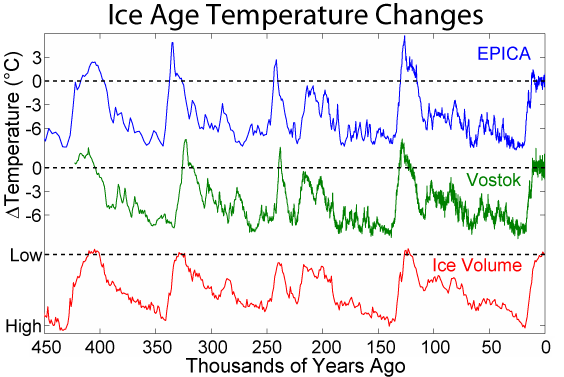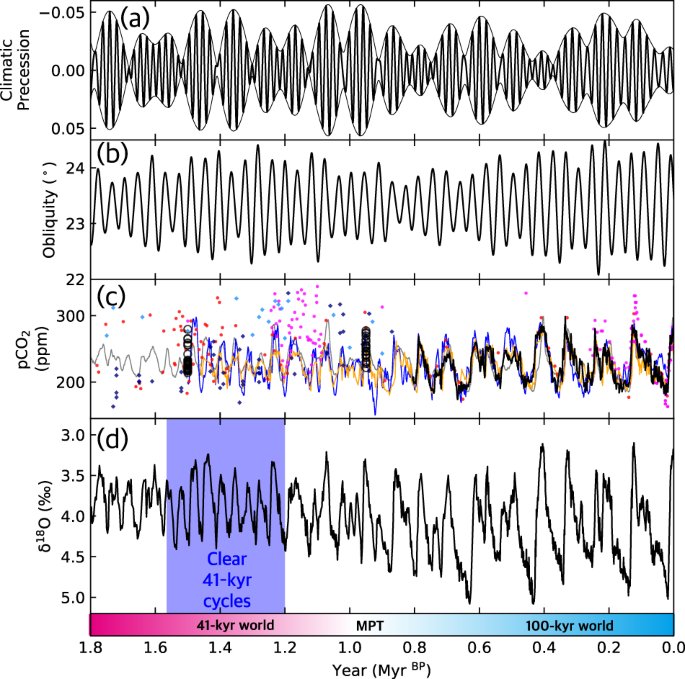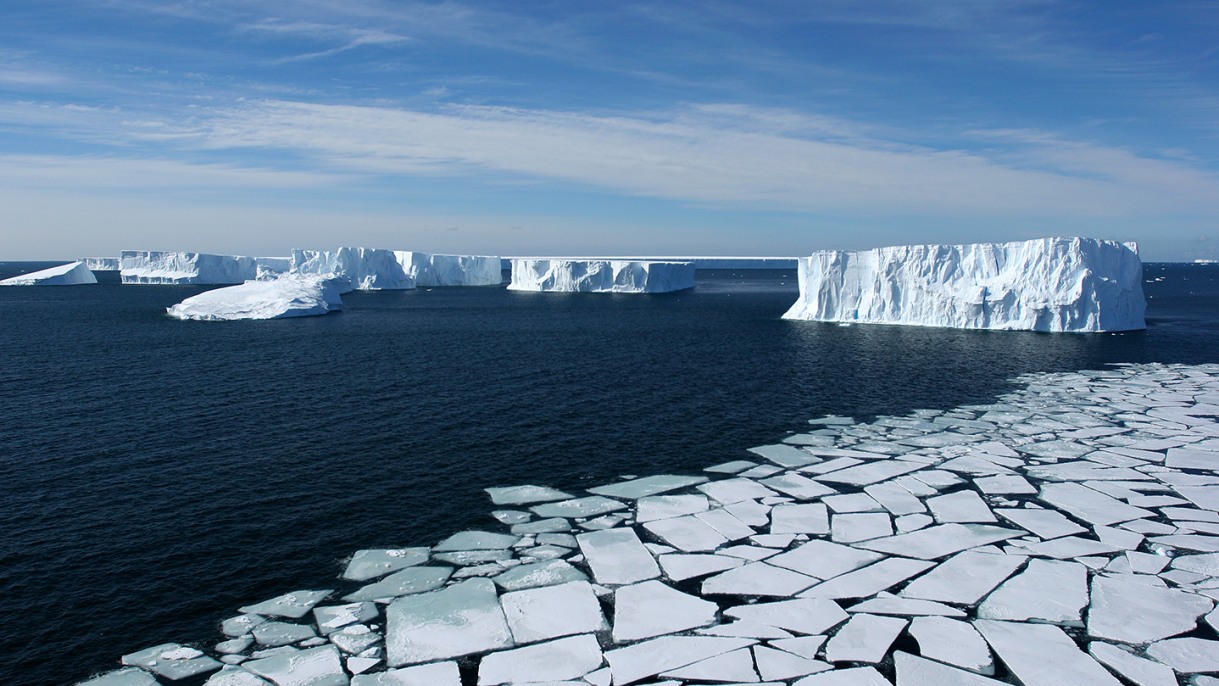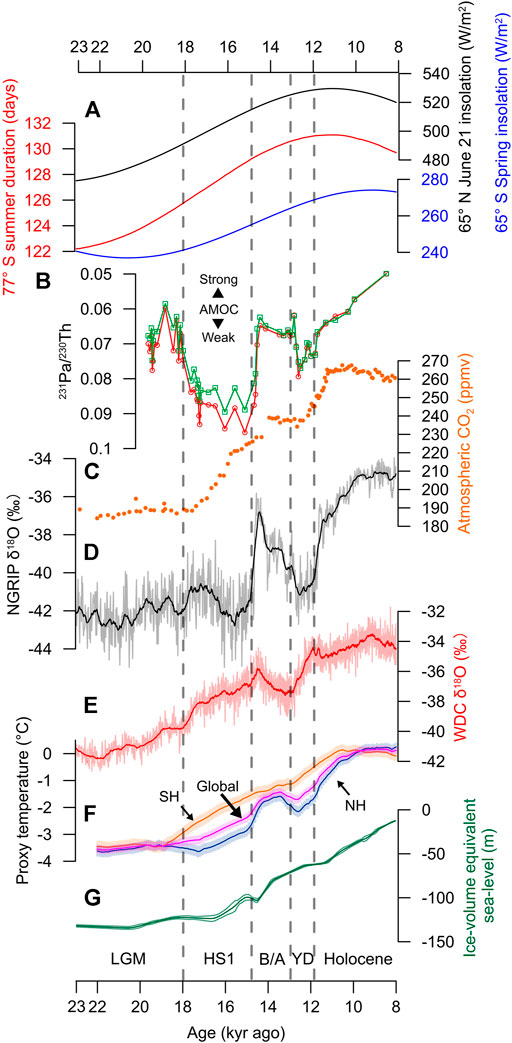The Earth has had an interesting temperature history. Over the past few billion years, it has been one of cooling. That includes the latest ice age, the Quaternary Period, which began 2.58 million years ago and continues through this day. That span of time has been divided into warmer and cooler periods termed interglacials and glacials, respectively. We are currently in a warmer interglacial period known as the Holocene. For the past 6,000 years, since a maximum temperature point known as the Holocene Climate Optimum, the Earth has been gradually cooling. However, the best estimates as to when the Earth will begin moving back into a glacial period are on the order of 50,000 years. Carbon dioxide from human emissions could theoretically delay that by another 50,000 years.
As noted, the Quaternary Period is divided into glacial and interglacial periods. In the first million years of the Quaternary, that cycle took place at a 41,000 year period with a relatively low thermal amplitude. At the Mid-Pleiocene Transition (MPT), however, the Earth underwent an "abrupt" shift to a high amplitude, 100,000 year period. The cause of the MPT is still under debate with the primary factors under discussion being the removal of regolith and exposure of unweathered bedrock by glacial scraping of the Laurentide and Cordillera ice sheet, a slow decrease in available CO2 due to decreased volcanism, increased carbonate weathering and the increased subduction of ocean sediments. Other discussions re CO2 availability concern the changes in vegetated area created by glacial growth and decline.
Another theory contends that the scraping of the major ice sheets and exposure of the bedrock beneath them dramatically increased the friction between ice and rock and slowed the movement and oscillation of the glacial sheets. Still another suggests that the phase locking of the Northern and Southern Hemispheric ice sheets allowed for a much greater build up of ice slowing the oscillation cycle.
Roughly a century ago, Serbian scientists Milutin Milankovitch:
"...hypothesized the long-term, collective effects of changes in Earth’s position relative to the Sun are a strong driver of Earth’s long-term climate, and are responsible for triggering the beginning and end of glaciation periods.
...
Milankovitch’s work was supported by other researchers of his time, and he authored numerous publications on his hypothesis. But it wasn’t until about 10 years after his death in 1958 that the global science community began to take serious notice of his theory. In 1976, a study in the journal Science by Hays et al. using deep-sea sediment cores found that Milankovitch cycles correspond with periods of major climate change over the past 450,000 years, with Ice Ages [glacial periods] occurring when Earth was undergoing different stages of orbital variation.
Several other projects and studies have also upheld the validity of Milankovitch’s work, including research using data from ice cores in Greenland and Antarctica that has provided strong evidence of Milankovitch cycles going back many hundreds of thousands of years. In addition, his work has been embraced by the National Research Council of the U.S. National Academy of Sciences.
Scientific research to better understand the mechanisms that cause changes in Earth’s rotation and how specifically Milankovitch cycles combine to affect climate is ongoing. But the theory that they drive the timing of glacial-interglacial cycles is well accepted."
The orbital dynamics that Milankovitch studied were three cycles:
1)
Eccentricity: This is basically the shape of the Earth's orbit which becomes, very slightly, more and less elliptical in a 100,000 year cycle. At its most circular, the Earth's orbit has an eccentricity of 0.0034. At its most elliptical, an eccentricity of 0.058. The eccentricity of a perfect circle is 0, that of a parabola is 1. Earth's eccentricity is currently decreasing. Our orbit is approaching maximum circularity. Eccentricity is why seasons are of different lengths in the northern and southern hemisphere and alters the Earth total solar irradiance (TSI) over the course of the solar year. When the Earth's orbit is its most eccentric, there is a 23% difference in TSI between perihelion and aphelion (the closest and furthest points from the sun, respectively). Changes in eccentricity are small and so this factor has a small, but non-zero, effect on the Earth's climate. Eccentricity is due primarily to the gravitation influence of Jupiter and Saturn, the two largest planets. As many of you know, at present, the Earth is actually closest to the sun in mid-Winter and furthest in mid-Summer.
2)
Obliquity: These are changes in the angle between the Earth's axis of rotation and our orbital plane. The Earth's obliquity varies between 22.1 and 24.5 degrees over a period of roughly 41,000 years. When the angle increases, the Earth's hemispheres experience warmer summers and colder winters. The effect is latitudinally dependent as higher latitudes (closer to the poles) see larger changes than lower latitudes closer to the Equator. Larger obliquity angles lead to deglaciation. The Earth's obliquity is currently at 23.4 degrees and is decreasing towards the next minimum in about 10,000 years.
3a)
Axial Precession: Precession is the wobble of Earth's rotational axis relative to the stellar background which occurs in a period of 25,771.5 years. This motion is similar to the wobble of the rotational axis of an off-center toy top. The precession angle controls the seasonal contrast of each hemisphere. As noted above, the Earth is currently closest to the sun in January. This tends to moderate northern hemisphere (NH) winter and increase the intensity of southern hemisphere (SH) summers. When the angle has rotated 180 degrees, these effects will be reversed. It is axial precession that will eventually remove Polaris and Sigma Octantis (aka Polaris Australis) from their "North Star" and "South Star" positions just as a few thousand years ago the stars Kochab and Pherkad held those positions.
3b)
Apsidial Precession: There is another precessive movement in which the plane of the Earth's orbit wobbles irregularly on a roughly 112,000 year cycle, due once more, primarily from the gravity of Jupiter and Saturn. The combination of the two movements produce a cycle of approximately 23,000 years.
As I'm sure all the regulars here have noted, poster ding and I have been in a protracted argument about the cause of the glacial-interglacial cycle. Ding has claimed that changes in ocean currents are responsible for all climate change for the past 3 million years, which would include the entire Quaternary and it ~30 glacial-interglacial cycles. Ding has repeatedly rejected Milankovitch's widely accepted theories that the trigger for that cycle is the orbital forcing described above. Shortly after our discussions began and following my pointing out to him that he had yet to find (and still has not found) a single source to support his idea that ocean current changes were responsible for the glacial-interglacial cycle, he altered his contention and now will not utter the term "glacial-interglacial cycle" and instead argues over and over again that changes in ocean currents are responsible for "abrupt climate changes". Initially, he attempted to include the glacial-interglacial transitions as just one more "abrupt climate change" but seems to have pulled back from that stance. It is possible that some portion of ding's motive in holding the positions he does in opposition of mainstream science and great deal of evidence is that orbital forcing produces the glacial-interglacial cycle with positive and negative feedback from CO2 released and withdraw to and from the atmosphere by temperature changes of the world's oceans and the gain and loss of arable land to oscillating ice sheets.
My position in this argument has consistently concerned the causative trigger of the glacial-interglacial cycle. I have not allowed myself to be drawn off into discussions of the D-O and Heinrich events that produce the "noise" commonly seen on ice core temperature and CO2 records that ding would dearly prefer. The transitions between glacial and interglacial periods are not D-O or Heinrich events. Ding likes to take my refusals to so engage as rejections of his comments about oceans and abrupt climate events. I am fully aware of the magnitude of the oceans heat capacity and what effects changes in ocean circulation, either from large meltwater impacts or tectonic movement can have on the Earth's global and regional climate. I am also aware that climate changes can alter ocean circulation producing complex and occasionally counterintuitive effects. However,
my sole point of contention with him at
this point is the causes of the glacial-interglacial cycle. Now ding has also claimed that the warming since the Industrial Revolution is not due to increased CO2 but, again, due to changes in ocean circulation. I save that discussion for another day.
I would like to point out that if ding had not even brought up glacial-interglacial cycles but had stuck to D-O and Heinrich events or even to full-up ice ages, I would have had no objection to the importance of ocean circulation, thermohaline circulation and tectonics changes in current paths. It was his insistence that orbital forcing did nothing and that the glacial-interglacial cycles were driven by changes in ocean currents, which causes he has never actually detailed.
So, in summation, I wish to encourage the readers here, once more, to review the results of asking Google or Google Scholar - or any search engine you wish to use - the following question: "WHAT IS THE CAUSE OF THE GLACIAL-INTERGLACIAL CYCLE?" I have done so now repeatedly and have gone through pages of the results. I have yet to find a single result that suggests ANYTHING other than Milankovitch's orbital forcing. The links below are from my last such search. Every one of these, at some points, specifically states or explicitly assumes that the glacial-interglacial cycle is triggered by Milankovitch's orbital forcing and, though the system and its responses are complex, I have yet to find ANY other triggering mechanisms even suggested.

scholar.google.com
J'espère que tu connais le français mieux que moi
"Among the longest astrophysical and astronomical cycles that might influence climate (and even among all forcing mechanisms external to the climatic system itself), only those involving variations in the elements of the Earth's orbit have been found to be significantly related to the long-term climatic data deduced from the geological record."
Milankovitch (Orbital) Cycles and Their Role in Earth's Climate - NASA Science
He calculated that Ice Ages occur approximately every 41,000 years. Subsequent research confirms that they did occur at 41,000-year intervals between one and three million years ago. But about 800,000 years ago, the cycle of Ice Ages lengthened to 100,000 years, matching Earth’s eccentricity cycle. While various theories have been proposed to explain this transition, scientists do not yet have a clear answer.
Variations in Earth’s orbit through time have changed the amount of solar radiation Earth receives in each season. Interglacial periods tend to happen during times of more intense summer solar radiation in the Northern Hemisphere. These glacial–interglacial cycles have waxed and waned throughout the Quaternary Period (the past 2.6 million years).
Glacial-interglacial cycles are believed to be driven by changes in the orbital pattern of the Earth that has periods of about 20 ka, 40 ka and 100 ka [25].
The onset of an interglacial (glacial termination) seems to require a reducing precession parameter (increasing Northern Hemisphere summer insolation), but this condition alone is insufficient. Terminations involve rapid, nonlinear, reactions of ice volume, CO2, and temperature to external astronomical forcing.
What drove these climate oscillations? Astronomers quickly came up with a suggestion. It had to do with cyclic changes in the Earth’s orbit.
Abstract. The glacial–interglacial cycles of the Quaternary exhibit 41 kyr periodicity before the Mid-Pleistocene Transition (MPT) around 1.2–0.8 Myr ago and ∼ 100 kyr periodicity after that. From the viewpoint of dynamical systems, proposed mechanisms generating these periodicities are broadly...

esd.copernicus.org
While we interpret the dominant periodicities of glacial cycles as the result of synchronization of internal self-sustained oscillations to the astronomical forcing, the Quaternary glacial cycles show facets of both synchronization and forced response.
An ice age is a long interval of time (millions to tens of millions of years) when global temperatures are relatively cold and large areas of the Earth are covered by continental ice sheets and alpine glaciers. Within an ice age are multiple shorter-term periods of warmer temperatures when...
geology.utah.gov
One significant trigger in initiating ice ages is the changing positions of Earth’s ever-moving continents, which affect ocean and atmospheric circulation patterns.
The timing of precession and obliquity cycles determined the duration of each glacial/interglacial period during the Early Pleistocene, according to dynamic ice-sheet-climate simulations of the glacial cycles between 1.6 and 1.2 million years ago.

www.nature.com
The lead-lag relationship between precession and obliquity controls the length of interglacial periods, the shape of the glacial cycle, and the glacial ice-sheet geometry.
Glacial cycles are driven by cyclical changes in Earth's orbital parameters: obliquity, precession, and eccentricity.
Climate simulations show how changes in Earth’s orbit alter the distribution of sea ice on the planet, helping to set the pace for the glacial cycle.

www.brown.edu
Each of these Milankovitch Cycles can influence the amount of sunlight the planet receives, which in turn can influence climate. The changes cycle through every 100,000, 41,000 and 21,000 years.
The Earth has gone through multiple ice ages in the past million years. Understanding the ice age dynamics is crucial to paleoclimatic study, and is helpful ...

www.frontiersin.org
The Earth has gone through multiple ice ages in the past million years. Understanding the ice age dynamics is crucial to paleoclimatic study, and is helpful for addressing future climate challenges. Though ice ages are paced by variations in Earth’s orbit geometry, how various climatic system components on the Earth respond to insolation forcing and interact with each other remains unclear.
A transition from low-amplitude sinusoidal obliquity (~41 ky) and precession (~23 ky) driven glacial/interglacial cycles to high-amplitude ~100 ky likely eccentricity-related sawtooth cycles seen between −1.25 My and −0.75 My BP (the Mid-Pleistocene transition or “MPT”) in FIT simulations disappears in BIT integrations depending on the details of how the regolith removal process is treated.
Abstract. The Earth's climate during the Quaternary is dominated by short warm interglacials and longer cold glaciations paced by external forcings such as changes in insolation. Although not observed in the solar radiation changes, the time series of the cycles display asymmetry since...

esd.copernicus.org
While it is mostly agreed that astronomical forcings trigger glacial–interglacial transitions, a similar shape is not observed in insolation changes, suggesting a nonlinear response by the climate system (Lisiecki and Raymo, 2007).

en.wikipedia.org

